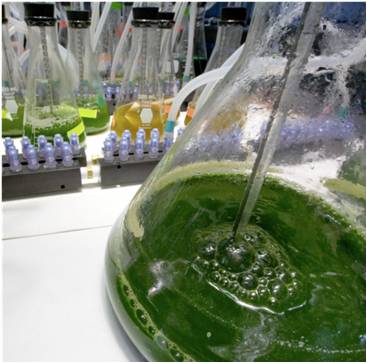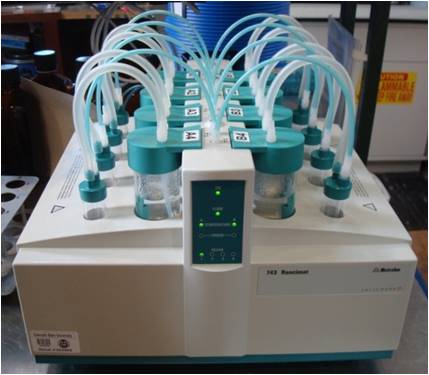



Characterization of Physical and Chemical Properties of Algae-Derived Alkyl Esters, Alcohols, Renewable Diesel and Renewable Synthetic Aviation Kerosene
A National Alliance for Advanced Biofuels and Bio-Products Research Study



Principal Investigator:
Associate Professor
Department of Mechanical Engineering
Colorado State University
Fort Collins, CO 80523-1374
Rationale
Microalgae is currently receiving strong consideration as an advanced biofuel feedstock because of its theoretically high yield (gallons/acre/year) in comparison to traditional terrestrial feedstocks. Microalgae lipids can be converted into a variety of biofuels including fatty acid methyl esters (e.g. biodiesel), renewable diesel (i.e. alkanes), renewable gasoline or synthetic paraffinic aviation kerosene. As detailed in the National Algal Biofuels Technology Roadmap, it is well recognized that for any of the above algae-derived biofuels to obtain widespread penetration into the transportation sector, they must qualify as “fit-for-purpose”. A fuel is said to be fit-for-purpose if it meets regulatory and customer requirements when delivered to the refueling location. To determine if a fuel is fit-for-purpose the following physical and chemical properties should be considered: energy density, oxidative/biological stability, lubricity, cold-weather performance, elastomer compatibility, corrosivity, emissions (regulated and unregulated), viscosity, distillation curve, autoignition characteristics (i.e. cetane and/or octane number), flash point, metal content, odor/taste thresholds, water tolerance, toxicity, environmental fate, sulfur and phosphorus content, etc.
In January 2010, the Department of Energy awarded a $48 million grant to the National Alliance for Advanced Biofuels and Bioproducts to create an algal biofuel consortium that covers aspects of the entire algal biofuels value chain including biology, cultivation, harvesting, extraction, fuel conversion and valuable co-products. As part of the $1.25 Million Colorado State University component of the consortium, the EECL Advanced Biofuels Research Group will be performing fuel characterization experiments on algal methyl esters, algal renewable diesel and algal jet fuel. The latter fuels will be produced by other members of the consortium. In addition, Prof. Marchese serves as the Fuel Conversion Team Leader for all of the Fuel Conversion members within the consortium.
Objectives of this Study
The proposed research study will focus on the following objectives:
Characterization of physical and chemical properties of algal methyl esters (AME), algal ethyl esters (AEE), algal renewable diesel (ARD), algal synthetic paraffinic kerosene (ASPK) and algal alcohols (AA) to quantify energy density, oxidative/biological stability, lubricity, cold-weather performance, corrosivity, viscosity, autoignition characteristics (i.e. cetane and/or octane number), flash point, metal content, water tolerance, sulfur and phosphorus content, etc. , and to determination of how these properties vary for different algal biofuel feedstocks.
Progress to Date
Thus far, we have focused on oxidative stability and ignition quality of algal methyl esters containing varying levels of methyl eicosapentaenoate (C20:5) and methyl docosahexaenoate (C22:6). Unlike renewable diesel, which consists of straight and branched alkanes, the physical and chemical properties of algal methyl ester biodiesel are directly related to the fatty acid composition of the algal lipids. Several microalgae species under consideration for wide scale cultivation such as Nannochloropsis produce lipids with substantially higher quantities of long chain-polyunsaturated fatty acids (LC-PUFA) in comparison to terrestrial feedstocks. It is expected that increased levels of LC-PUFA will be problematic in terms of meeting all of the current ASTM specifications for biodiesel. Moreover, these same LC-PUFA fatty acids, such as eicosapentaenoic acid (EPA: C20:5) and docosahexaenoic acid (DHA: C22:6) currently have high nutritional value thereby making separation of these compounds economically attractive. Given the uncertainty in the future value of these LC-PUFA compounds and the economic viability of the separation process, the goal of this work was to examine the fuel properties of algal methyl esters with varying levels of EPA and DHA. Oxidative stability tests were conducted using a Metrohm 743 Rancimat system. Cetane Number tests were performed using a Waukesha FIT ignition quality apparatus. Tests were conducted with synthetic algal oil blends synthesized from various sources to match the fatty acid compositions of several algae strains subjected to varying removal amounts of 0 to 100 % LC-PUFA. In addition, tests were also conducted with real algal methyl esters produced from multiple sources. The results suggest that removal of 45 to 65% of the LC-PUFA from Nannochloropsis-based algal methyl esters would be sufficient for meeting existing ASTM specifications for oxidative stability. However, to meet the current ASTM Cetane Number specifications, nearly 100% of the LC-PUFA would have to be removed from these same algal methyl esters.
Project Personnel
Harrison Bucy, M.S., 2011 "Oxidative Stability and Ignition Quality of Algae Derived Methyl Esters"
Esteban Hincapie, Ph.D Student
Last Updated: April 20, 2011